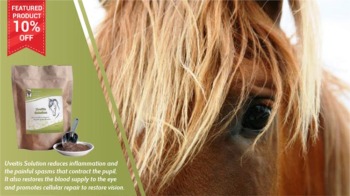Care and Management of a Horse with a Tendon Injury
When horses move, their tendons must be flexible enough to stretch and contract within a range of 1 to 3 inches. If a tendon is pushed beyond this linear “stress capacity,” tendon injury is likely to occur. Such damage to the tendon usually involves rupture of the tendon fibers. The number of ruptured fibers is directly related to the seriousness of the injury.
Signs of tendon injury and what to do
Heat and swelling are the first signs of a mild to moderate tendon injury. If care is not taken, the swelling will progress over time with increasing degrees of heat and pain.
Mild injuries, such as strains and sprains, will most likely display heat and swelling with no lameness. At this point, healing is still possible within twenty four to forty eight hours. Put your horse in a paddock where movement is controlled by the injured animal not by the pecking order of the herd. An absolute requirement for this healing process is that your horse must not be returned to a demanding workout schedule until you are completely certain there is no heat and palpable swelling. After all symptoms have disappeared, give your horse another week's vacation from training. Riding in the paddock at a walk is not a problem during this week.
In both moderate to severe injuries, such as a rupture, where degeneration of the tendon fibers are very likely within just a few days, your horse will display lameness in accord with the severity of the damage to the tendon fibers. Injuries of this severity require an extraordinary amount of patience and care by the horse caretaker. Put your horse in a paddock, if possible, with a guaranteed good "friend" that will not encourage, force or do anything to generate a severe movement in the injured horse. Massage your horse's injured leg with a soothing liniment twice daily to increase circulation to the hurt area and spend time with your horse. You really need to do this for weeks and trust your horse's sense of what movement is best for them. Wait patiently for no swelling or heat in the originally damaged site.
Re-Injury
Re-injury often leads to damage that is difficult to correct.
A well-designed study at the Animal Health Trust in Newmarket, England demonstrated that re-injury is directly related to the nature of the previous injury, the healing stage and the subsequent usage after the injury. Clearly, re-injury is more often than not, a result of returning the horse to "inappropriate" movement for the horse's stage of healing. The key issue is to allow some movement so that the injury has good circulation but not so much as to stress it. Given the right circumstances, the horse may well be the best judge of ‘appropriate’ movement.
I realize that my endorsement of movement for the horse with a tendon injury is a break from conventional practices, yet it has been my observation of these horses that they must move to facilitate the healing process of tendon injuries. Stall confinement is frequently given as a part of tendon injury recovery but it should be understood that confining a horse will reduce blood circulation to the injured area reducing the essential nutrients and oxygen needed for recovery.
Palpation Technique
Horses that are in competition and competitive training are at the greatest risk for tendon injury. Do remember, though, that your horse in the pasture can rupture a tendon just as easily as a racehorse if they are running in the mud and slip. As owners and trainers we need to recognize that the border between tendon soundness and tendon injury is very minute. If you catch a tendon problem immediately, you might just be able to prevent the problem from reaching a rupture stage.
Use the palpation technique offered below as a way to gently feel for tissue damage along the tendons most likely to be affected.
Place your thumb and fore fingers gently around the tendon behind the elbow on the front limb and slowly move your hand down to just above the knee. On the rear limb, start behind the stifle, below the rump and slowly move your hand to just behind the hocks. Next you will move your hand from these end-points along the rear of your horse's limbs to the coronary band.
What you are feeling for is palpable heat and slight swelling. If you even think that you feel these sensations give your horse a week's vacation from any workouts. We recommend our Tendon Repair Solution as an important part of your care and management program. Click here for more information about how our product can assist in a more efficient, healthier repair to your horse's tendon injury









